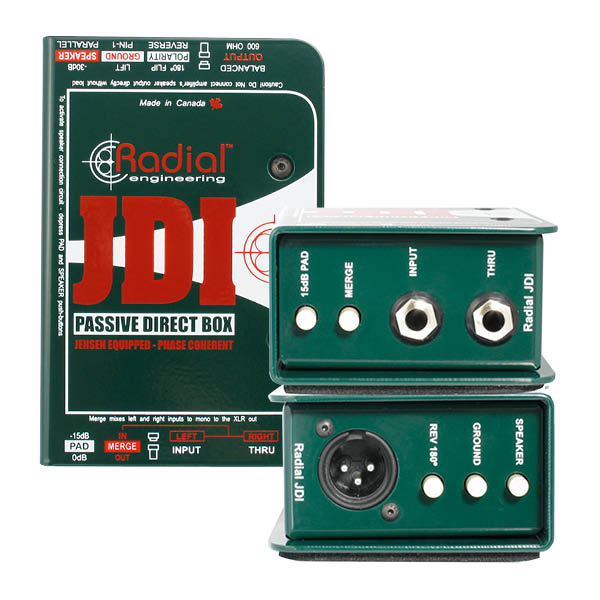
What exactly is a Direct Box?
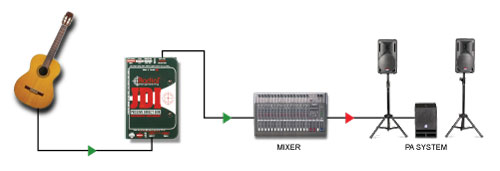
This enables the signal to travel distances of 100 meters (300 feet) without adding appreciable noise. The output of a DI box is mic level – thus the balanced output signal is treated just like a microphone. When playing live, the mixing console is usually positioned in the house (front of house or FOH position) which is often 50 to 100 meters away. Most instruments such as bass guitar, acoustic guitar and keyboards are connected to a DI box and mixed at FOH. For the sound engineer, capturing the direct sound of the instrument separately from being processed by the artist on stage usually makes it easier to amplify the signal as it can be optimized for the room.
-
‘Balanced’ / ‘Unbalanced’
- Balanced audio signals have a much higher rejection of noise and interference, and use XLR or ¼″ TRS connectors that carry two signal conductors per channel. Unbalanced audio signals, such as those used by guitars and pedal effects over ¼′ TS cables, are more susceptible to noise and should only be run for short distances.
-
‘Impedance’
- Is the total opposition to electrical flow, measured in ohms. Guitar and amplifiers use signals that are known as HI-Z, or high-impedance, while pro audio devices like direct boxes and mixers work with Low-Z, or low-impedance signals.
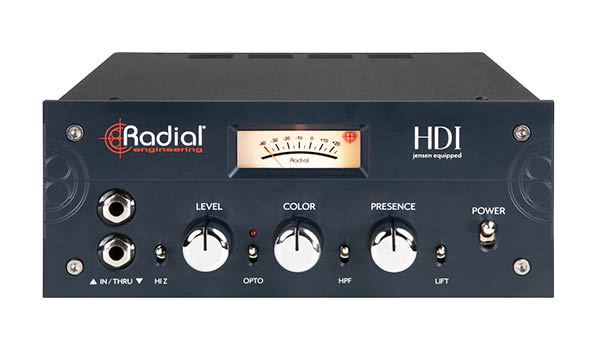
Why do I need a DI Box?
In the studio, recording from a separate room (isolation booth) enables the engineer to capture a direct sound from the instrument using a direct box in addition to adding a mic in front of the amplifier to capture the tone generated by the amp. When recording in the control room, you may or may not need a DI box, depending on the tone you are looking for. Most mixer inputs have a ‘one size fits all’ type of instrument input that may not flatter your particular instrument. A good DI box is optimized to interface with your mixing desk or recording system by presenting the instrument with the right input impedance and converting it to a balanced signal ideal for the console or interface. This can take the edge off the instrument for a smoother, more natural sound. Using a good DI box in the studio also allows for a clean recording of the instrument signal which can then be later played back for Reamping.
-
‘Reamping’
- A creative process that takes any recorded audio signal (typically a guitar track) and sends it back through a guitar amplifier or pedal chain to be recorded a second time. This can be used to make subtle changes to the signal or employed as a unique sound effect.
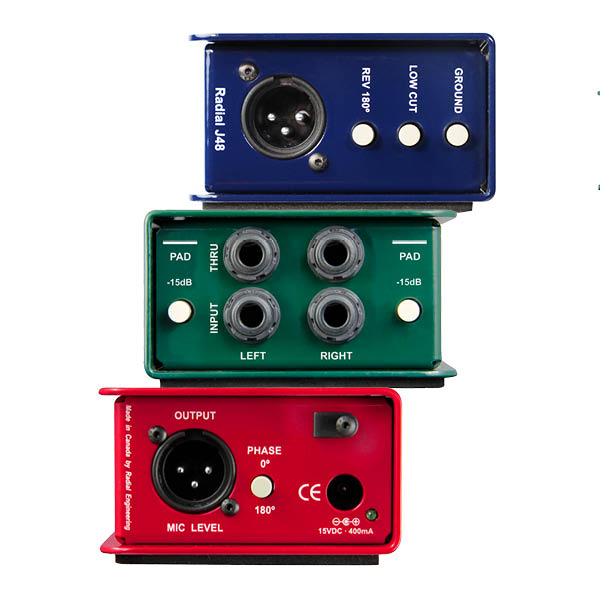
What kind of DI box should I get?
This is like asking what kind of microphone should I buy. There are basically two types of direct boxes — an active direct box and a passive direct box. But, just as there are all kinds of microphones for all types of applications, there are different kinds, or configurations, of direct boxes for different applications. Just as you could use a dynamic microphone like a Shure SM58 to capture the sound of just about anything, you could buy a Radial JDI passive direct box and be pretty much set. But sometimes, using a condenser mic can give you the extra reach to capture more sparkle from an acoustic guitar or more detail from a voice when recording. In this case, an active DI box like the Radial J48 is the best choice. Like dynamic microphones, a passive direct box tends to be able to handle more signal level without distortion, while a condenser mic – like an active DI box – generally produces a wider frequency response while being more sensitive. And just as most studios and live stages are equipped with a selection of dynamic and condenser mics, both passive and active DI boxes are often used side by side. The choice usually comes down to personal preference.
A simple rule of thumb:
If the source is active, use a passive DI box
If the source is passive, use an active DI box
So if you have an old Fender Precision bass with magnetic pickups, an active direct box will probably work best as the buffer will generate plenty of signal for the PA system while reducing the load on the instrument. If on the other hand, you have a new, high-output active bass with a 9-volt battery inside, you can turn up your volume with confidence knowing that your passive Radial ProDI passive direct box will easily handle the signal without distortion.
Over the years, industry standards for direct boxes have become commonplace. For instance, most engineers prefer to run an acoustic guitar through an active DI like the Radial J48 as it is noted that there is some ‘air’ or openness that can found when pairing an acoustic with an active DI box. On noise-plagued AC powered devices like keyboards, electronic drums, DJ mixers and other active sources, most engineers will prefer to use a passive DI box like the Radial ProD2 or JDI Stereo. This is because a passive direct box typically handles more level without distortion and is also very efficient in eliminating hum and buzz caused by ground loops.
-
‘Active’
- Active devices require power to operate, either in the form of a power cable, a battery, or via 48V phantom power from a mixer.
-
‘Passive’
- Passive audio devices function without any need for power – you simply connect them in your signal chain and they are ready to go.
-
‘Buffer’
- A buffer is a unity-gain preamp often found in active audio circuits. Buffers can help drive signals over long distances without significant signal loss or degradation, and they can prevent level loss when splitting signals to multiple destinations.
-
‘Ground Loop’
- Ground loops are one of the largest sources of noise and hum in audio systems, and they occur when two or more devices share the same ground reference but have a different voltage potential between them. The most common solutions to ground loop noise are inserting an audio transformer in the signal path or lifting the audio ground conductor (shield) on the connection between the devices.
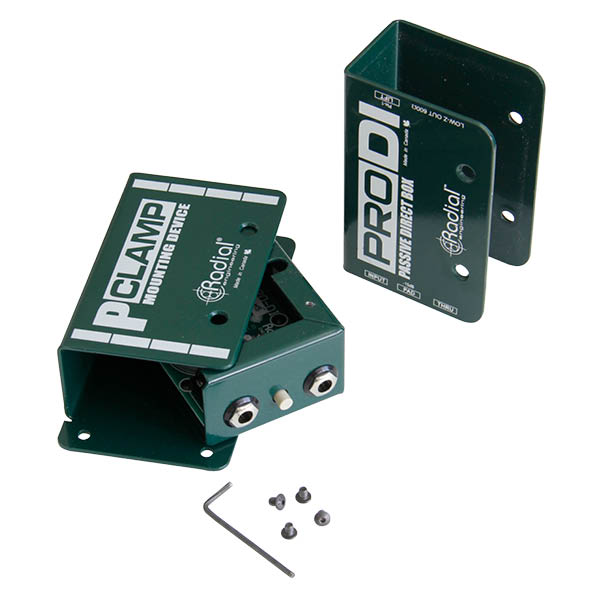
How much should I spend on a DI box?
We recommend the 5:1 rule, where if you spend $1,000 on an instrument, you should probably invest $200 in a direct box. So if your guitar is worth $500, spending $100 on a direct box is probably the right ratio. A comparable example would be to think if you were to spend $2,000 on a great guitar, would you only play through a $30 guitar amp? Probably not.
An active DI box is a unity gain preamp. Preamps can cost anywhere from $30 to $10,000. And just like guitars, basses, keyboards and studio preamps – direct boxes come in all shapes, sizes and quality levels based on your expectations. There is no shortcut to quality. Radial DIs are used on the world’s top stages and in the best studios because they are designed to deliver the utmost quality day in and day out. We are confident that once you listen to the difference, you will come to appreciate the benefits.
Radial DI boxes come with a 3-year transferable warranty which means that if you decide to sell your Radial DI within the warranty period, the warranty will still be good for the next owner. And because Radial DIs are in demand, they tend to have a much higher resale value.
As described above there are no hard and fast rules. It comes down to taste and application.
-
‘Unity Gain’
- Unity gain refers to the point at which the output signal level matches the input signal level. Connecting your instrument to a unity gain device means that the overall signal level will not be affected.
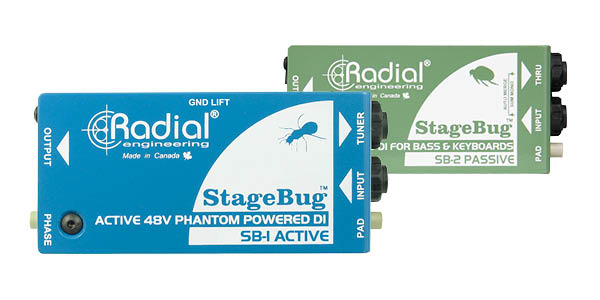
Next Steps


